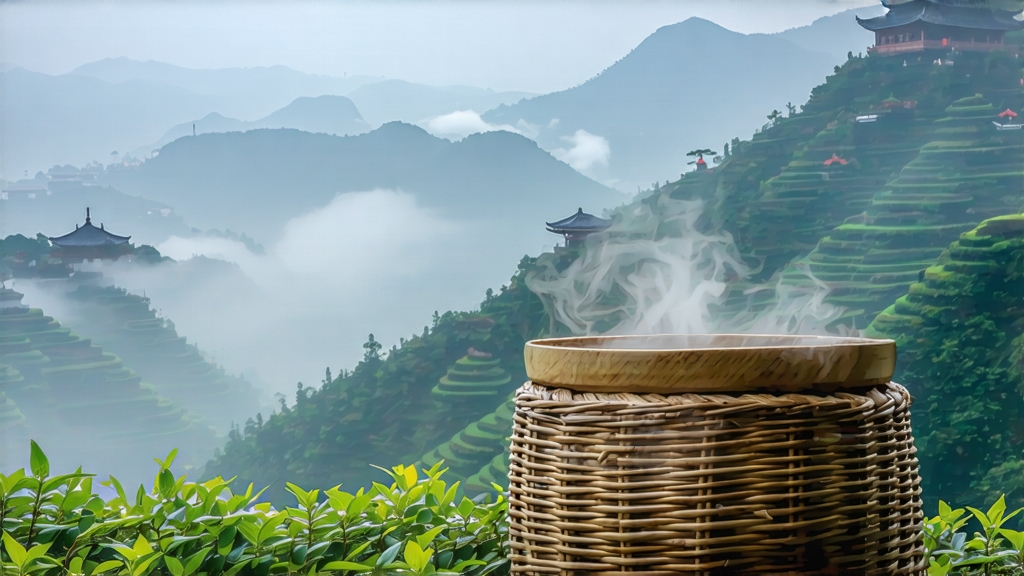
Hidden above the perpetual cloud belt of Sichuan’s western escarpment lies a tiny plateau whose name every Chinese tea scholar whispers with reverence: Meng Ding—literally “the Summit of Meng.” At 1,450 m the air is thin, the soil is a loose yellow loam laced with quartz, and the temperature swings twelve degrees between dawn and noon. It is here, among terraced groves of seed-propagated camellia sinensis var. sinensis bushes first planted in the Tang dynasty (618-907 CE), that Meng Ding Huang Ya—Meng Ding Yellow Bud—takes the throne as the most aristocratic of China’s scant yellow teas.
A ROYAL PAST
According to the 1541 county gazetteer of Mingshan, a monk named Gan Lu (“Sweet Dew”) presented a foil-wrapped canister of “yellow sprout” to Emperor Li Shimin in 742 CE. The infusion’s liquor was so brilliantly golden and its aroma so reminiscent of millet sponge-cake that the court immediately designated Meng Ding a tribute zone. For the next 1,100 years every spring equinox saw a caravan of mules descend the plank-roads carrying sealed bamboo cylinders stamped with the imperial dragon. When the Qing collapsed in 1911 the tribute system vanished, and with it the exact recipe. Only a handful of hereditary monks and one peasant clan, the Wu family, kept the craft alive in the shadow of the 1,000-year-old Ganlu Temple. Rediscovery came in 1959 when the Sichuan Tea Company, combing archives for export novelties, re-established Meng Ding Huang Ya as one of China’s Ten Famous Teas.
THE MICRO-CATEGORY
Western catalogues often list yellow tea as a single genre, yet within China the niche is subdivided by leaf style: bud-only, bud-with-leaf, and large-leaf yellow. Meng Ding Huang Ya is the archetype of the first—picked strictly as single buds, or at most bud-with-half-unfurled-leaf, when the shoot reaches 12–18 mm. The harvest window spans five days around the solar term Qing Ming (early April), during which morning fog slows photosynthesis, doubling the amino acid reservoir and gifting the famous “spring sweetness” (xian).
CRAFT: THE ART OF MEN HUANG
What converts a green bud into a yellow one is the enigmatic men huang (“sealed yellowing”) protocol, a two-stage sauna that teases out mellow chestnut notes while stripping away the grassy astringency typical of early-spring greens.
-
Kill-Green with Bamboo
Within thirty minutes of plucking the buds are hand-tossed in a wok heated to 140 °C. The motion is a gentle flicking, almost like flipping a crepe, performed with a thin-arm bamboo rake. Surface enzymes are neutralised yet the bud’s core moisture remains above 62 %—critical for the next step. -
First Wrapping
The semi-dry buds are piled 3 cm deep on cotton cloth, wrapped into a loose parcel, and tucked into a bamboo steam basket. The basket is slid into a sealed pine box maintained at 35 °C and 85 % humidity for 40 minutes. Chlorophyll begins to degrade; flavonols oxidise just enough to shift colour from jade to pale maize. -
Second Firing & Re-wrapping
After a second wok pass at 80 °C the buds are again wrapped, this time in double-layer rice paper, and left for six hours. A faint microbial bloom (mostly Wallemia sebi) generates a popcorn-like aroma compound, 2-acetyl-1-pyrroline, the same molecule that perfumes basmati rice. -
Low-Temperature Desiccation
Finally the buds are cradled on horse-hair trays and dried at 45 °C for three hours until moisture drops to 5 %. The finished tea looks like golden needles capped with minute downy hooks; a single gram contains roughly 220 buds.
BREWING LIKE A SICHUAN MONK
Water: spring water at 85 °C. Anything hotter scorches the down and releases tannic bitterness.
Leaf ratio: 2 g per 80 ml, or about one level teaspoon per gaiwan.
Vessel: a porcelain gaiwan of 100 ml allows observation of the “three sinks” dance: on the first infusion half the buds drift down, on the second the remainder cascade, and on the third all rise again—a sign